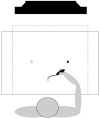Movement structure in young and elderly adults during goal-directed movements of the left and right arm
- PMID: 18556103
- PMCID: PMC2663567
- DOI: 10.1016/j.bandc.2008.05.002
Movement structure in young and elderly adults during goal-directed movements of the left and right arm
Abstract
Elderly adults often exhibit performance deficits during goal-directed movements of the dominant arm compared with young adults. Recent studies involving hemispheric lateralization have provided evidence that the dominant and non-dominant hemisphere-arm systems are specialized for controlling different movement parameters and that hemispheric specialization may be reduced during normal aging. The purpose was to examine age-related differences in the movement structure for the dominant (right) and non-dominant (left) during goal-directed movements. Young and elderly adults performed 72 aiming movements as fast and as accurately as possible to visual targets with both arms. The findings suggest that previous research utilizing the dominant arm can be generalized to the non-dominant arm because performance was similar for the two arms. However, as expected, the elderly adults showed shorter relative primary submovement lengths and longer relative primary submovement durations, reaction times, movement durations, and normalized jerk scores compared to the young adults.
Figures






Similar articles
-
Competition for limited neural resources in older adults leads to greater asymmetry of bilateral movements than in young adults.J Neurophysiol. 2020 Apr 1;123(4):1295-1304. doi: 10.1152/jn.00405.2019. Epub 2020 Jan 8. J Neurophysiol. 2020. PMID: 31913762 Free PMC article.
-
Decline in motor prediction in elderly subjects: right versus left arm differences in mentally simulated motor actions.Cortex. 2008 Oct;44(9):1271-8. doi: 10.1016/j.cortex.2007.07.008. Epub 2007 Dec 27. Cortex. 2008. PMID: 18761141 Clinical Trial.
-
Hemispheric specialization in the co-ordination of arm and trunk movements during pointing in patients with unilateral brain damage.Exp Brain Res. 2003 Feb;148(4):488-97. doi: 10.1007/s00221-002-1325-0. Epub 2002 Dec 21. Exp Brain Res. 2003. PMID: 12582832
-
Task-dependent asymmetries in the utilization of proprioceptive feedback for goal-directed movement.Exp Brain Res. 2007 Jul;180(4):693-704. doi: 10.1007/s00221-007-0890-7. Epub 2007 Feb 13. Exp Brain Res. 2007. PMID: 17297548
-
Origins of submovements in movements of elderly adults.J Neuroeng Rehabil. 2008 Nov 13;5:28. doi: 10.1186/1743-0003-5-28. J Neuroeng Rehabil. 2008. PMID: 19014548 Free PMC article.
Cited by
-
The effects of age and postural constraints on prehension.Exp Brain Res. 2023 Jul;241(7):1847-1859. doi: 10.1007/s00221-023-06647-0. Epub 2023 May 31. Exp Brain Res. 2023. PMID: 37256337
-
Aging of sensorimotor processes: a systematic study in Fitts' task.Exp Brain Res. 2013 Jul;228(1):105-16. doi: 10.1007/s00221-013-3542-0. Epub 2013 May 7. Exp Brain Res. 2013. PMID: 23649969
-
Smoothness metric during reach-to-grasp after stroke: part 2. longitudinal association with motor impairment.J Neuroeng Rehabil. 2021 Sep 24;18(1):144. doi: 10.1186/s12984-021-00937-w. J Neuroeng Rehabil. 2021. PMID: 34560898 Free PMC article.
-
Normal aging affects unconstrained three-dimensional reaching against gravity with reduced vertical precision and increased co-contraction: a pilot study.Exp Brain Res. 2022 Apr;240(4):1029-1044. doi: 10.1007/s00221-021-06280-9. Epub 2022 Feb 16. Exp Brain Res. 2022. PMID: 35171307 Free PMC article.
-
Age-related variability in performance of a motor action selection task is related to differences in brain function and structure among older adults.Neuroimage. 2014 Feb 1;86:326-34. doi: 10.1016/j.neuroimage.2013.10.016. Epub 2013 Oct 12. Neuroimage. 2014. PMID: 24125791 Free PMC article.
References
-
- Alberts JL, Saling M, Adler CH, Stelmach GE. Disruptions in the reach-to-grasp actions of Parkinson’s patients. Experimental Brain Research. 2000;134(3):353–362. - PubMed
-
- Amrhein PC, Stelmach GE, Goggin NL. Age differences in the maintenance and restructuring of movement preparation. Psychology and Aging. 1991;6(3):451–466. - PubMed
-
- Amrhein PC, Theios J. The time it takes elderly and young individuals to draw pictures and write words. Psychology and Aging. 1993;8(2):197–206. - PubMed
-
- Annett J, Annett M, Hudson PT, Turner A. The control of movement in the preferred and non-preferred hands. Quarterly Journal of Experimental Psychology. 1979;31(Pt 4):641–652. - PubMed
Publication types
MeSH terms
Grants and funding
LinkOut - more resources
Full Text Sources
Medical

